
A fighting game is a genre of video game that involves combat between two or more characters. Fighting game combat often features mechanics such as blocking, grappling, counter-attacking, and chaining attacks together into "combos". Characters generally engage in battle using hand-to-hand combat—often some form of martial arts. The fighting game genre is related to, but distinct from, the beat 'em up genre, which pits large numbers of computer-controlled enemies against one or more player characters.

Pac-Man, originally called Puck Man in Japan, is a 1980 maze action video game developed and released by Namco for arcades. In North America, the game was released by Midway Manufacturing as part of its licensing agreement with Namco America. The player controls Pac-Man, who must eat all the dots inside an enclosed maze while avoiding four colored ghosts. Eating large flashing dots called "Power Pellets" causes the ghosts to temporarily turn blue, allowing Pac-Man to eat them for bonus points.
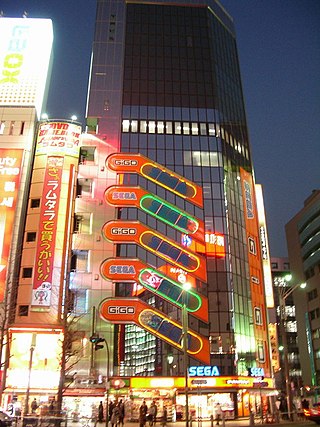
An amusement arcade, also known as a video arcade, amusements, arcade, or penny arcade, is a venue where people play arcade games, including arcade video games, pinball machines, electro-mechanical games, redemption games, merchandisers, or coin-operated billiards or air hockey tables. In some countries, some types of arcades are also legally permitted to provide gambling machines such as slot machines or pachinko machines. Games are usually housed in cabinets.

Marble Madness is an arcade video game designed by Mark Cerny and published by Atari Games in 1984. It is a platform game in which the player must guide a marble through six courses, populated with obstacles and enemies, within a time limit. The player controls the marble by using a trackball. Marble Madness is known for using innovative game technologies: it was Atari's first to use the Atari System 1 hardware, the first to be programmed in the C programming language, and one of the first to use true stereo sound.

Pole Position is an arcade racing simulation video game released by Namco in 1982 and licensed to Atari, Inc. for US manufacture and distribution, running on the Namco Pole Position arcade system board. It is considered one of the most important titles from the golden age of arcade video games. Pole Position was an evolution of Namco's earlier arcade racing electro-mechanical games, notably F-1 (1976), whose designer Sho Osugi worked on the development of Pole Position.

Harrods Limited is a department store located on Brompton Road in Knightsbridge, London, England. It is currently owned by the state of Qatar via its sovereign wealth fund, the Qatar Investment Authority. The Harrods brand also applies to other enterprises undertaken by the Harrods group of companies, including Harrods Estates, Harrods Aviation and Air Harrods.
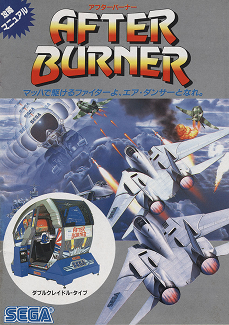
After Burner is a rail shooter arcade video game developed and released by Sega in 1987. The player controls an American F-14 Tomcat fighter jet and must clear each of the game's eighteen unique stages by destroying incoming enemies. The plane is equipped with a machine gun and a limited supply of heat-seeking missiles. The game uses a third-person perspective, as in Sega's earlier Space Harrier (1985) and Out Run (1986). It runs on the Sega X Board arcade system which is capable of surface and sprite rotation. It is the fourth Sega game to use a hydraulic "taikan" motion simulator arcade cabinet, one that is more elaborate than their earlier "taikan" simulator games. The cabinet simulates an aircraft cockpit, with flight stick controls, a chair with seatbelt, and hydraulic motion technology that moves, tilts, rolls and rotates the cockpit in sync with the on-screen action.

Space Harrier is a third-person arcade rail shooter game developed by Sega and released in 1985. It was originally conceived as a realistic military-themed game played in the third-person perspective and featuring a player-controlled fighter jet, but technical and memory restrictions resulted in Sega developer Yu Suzuki redesigning it around a jet-propelled human character in a fantasy setting. The arcade game is controlled by an analog flight stick while the deluxe arcade cabinet is a cockpit-style linear actuator motion simulator cabinet that pitches and rolls during play, for which it is referred as a taikan (体感) or "body sensation" arcade game in Japan.
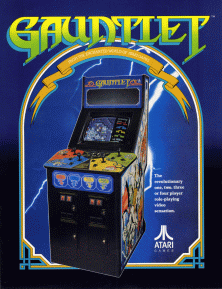
Gauntlet is a 1985 fantasy-themed hack-and-slash arcade game developed and released by Atari Games. It is noted as being one of the first multiplayer dungeon crawl arcade games. The core design of Gauntlet comes from 1983 Atari 8-bit dungeon crawl game Dandy, which resulted in a threat of legal action. It also bears striking similarities to the action-adventure maze game Time Bandit (1983).

Super Sprint is a racing video game released by Atari Games and Midway Games in 1986. Up to three players drive Formula One-like cars on a circuit that is viewed from above. The game is a successor to Gran Trak 10 and the Sprint series, which were black-and-white games from the 1970s. A sequel, Championship Sprint, was released later in the same year.
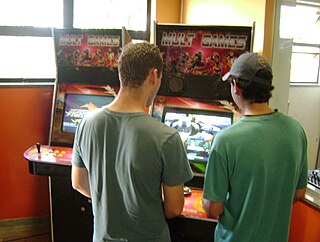
An arcade cabinet, also known as an arcade machine or a coin-op cabinet or coin-op machine, is the housing within which an arcade game's electronic hardware resides. Most cabinets designed since the mid-1980s conform to the Japanese Amusement Machine Manufacturers Association (JAMMA) wiring standard. Some include additional connectors for features not included in the standard.

Hang-On is an arcade racing game released by Sega in 1985 and later ported to the Master System. In the game, the player controls a motorcycle against time and other computer-controlled bikes. It was one of the first arcade games to use 16-bit graphics and uses the Super Scaler arcade system board, created with design input from Yu Suzuki, as technology to simulate 3D effects. The deluxe cabinet version also introduced a motion-controlled arcade cabinet, where the player's body movement on a large motorbike-shaped cabinet corresponds with the player character's movements on screen.
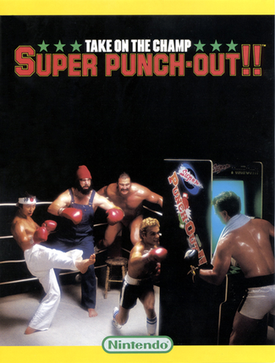
Super Punch-Out!! is a 1984 arcade boxing game by Nintendo. The sequel to Punch-Out!!, it follows the same format while adding several new features and characters. Along with punching, blocking and dodging, players also have the ability to duck. The game also saves and displays the three fastest knockout times, while the game's difficulty is increased.
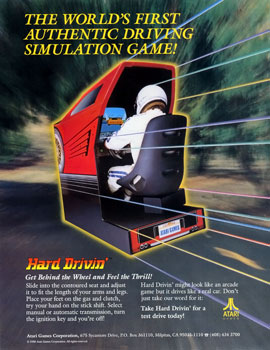
Hard Drivin' is a driving simulation video game developed by Atari Games in 1989. It invites players to test drive a sports car on courses that emphasize stunts and speed. The game features one of the first 3D polygon driving environments via a simulator cabinet with a force feedback steering wheel and a custom rendering architecture.

WEC Le Mans, known as WEC Le Mans 24 in Japan, is a racing simulation video game released in arcades by Konami in 1986. It was the first racing video game to depict the 24 Hours of Le Mans World Endurance Championship (WEC). The Lap of Le Mans is split up into three sections, during which the time of day changes from day to dusk, dusk to night, and night to dawn.
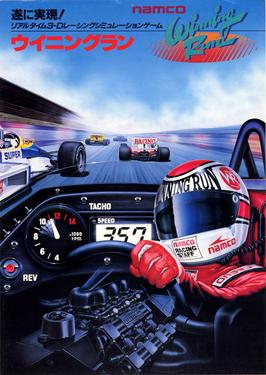
Winning Run is a first-person arcade racing simulation game developed and published by Namco in late December 1988 in Japan, before releasing internationally the following year. The player pilots a Formula One racer, with the objective being to complete each race in first place, all while avoiding opponents and other obstacles, such as flood-hit tunnels, pits and steep chambers. It was the very first game to run on the Namco System 21 arcade hardware, capable of 3D shaded polygons.
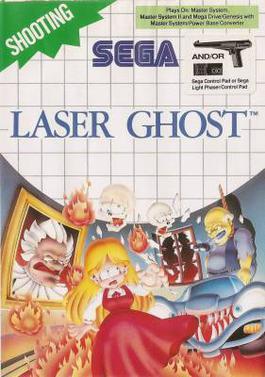
Laser Ghost is a horror-themed light gun shooter arcade video game released by Sega in 1990. The game is patterned after the films Ghostbusters and Poltergeist III, casting the player as a ghost hunter. There are three mounted guns set up on the cabinet, representing the three members of a ghost hunting team. The game puts the players in the role of Bill, Max and Carol, who must rescue a little girl kidnapped by a blue gargoyle, as well as protect the city from the ghost menace. A Master System game with the same title was released in 1991 exclusively for Europe, but was not based on the arcade original.
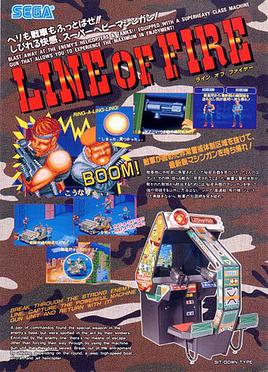
Line of Fire is a first-person light gun shooter game developed by Sega and released for arcades in 1989. It was released with two arcade cabinet versions, a standard upright and a sit-down cockpit, both featuring two positional guns. The cockpit design allows the player(s) to sit down while playing the game, while having two-handed machine guns, controlled by a potentiometer-controlled gun alignment software system. The game follows a two-man commando unit as they try to escape from a terrorist facility after seizing a prototype weapon.

The Evolution Championship Series, commonly known as Evo, is an annual esports event that focuses exclusively on fighting games. The tournaments are completely open and use the double elimination format. As with Super Battle Opera, contestants travel from all over the world to participate, most notably from Japan. The first Evolution was originally held as a Super Street Fighter II Turbo and Street Fighter Alpha 2 tournament called the Battle by the Bay. It changed its name to Evo in 2002. Every successive tournament has seen an increase of attendees. It has been held at various venues across the Las Vegas Valley since 2005. As of 2021, the event is jointly owned by Sony Interactive Entertainment and the Endeavor esports venture RTS.

Death Race is an arcade driving video game developed and released by Exidy in the United States, first shipping to arcade distributors in April 1976. The game was a modification of Exidy's 1975 game Destruction Derby in which players crashed into cars to accrue points. In Death Race, the objective became to run into "gremlins" to gain score. The game could be played with one or two players controlling different cars. The original working title for the game which appeared on some early advertisements was Death Race 98.



















